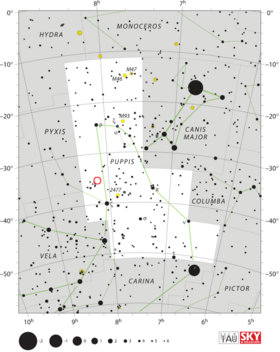Astronomy:CP Puppis
| Observation data Equinox J2000.0]] (ICRS) | |
|---|---|
| Constellation | Puppis |
| Right ascension | 08h 11m 46.0635s[1] |
| Declination | −35° 21′ 04.9863″[1] |
| Apparent magnitude (V) | 0.7 Max. 18 Min.[2] |
| Characteristics | |
| Variable type | Nova[2] |
| Astrometry | |
| Radial velocity (Rv) | +37[3] km/s |
| Proper motion (μ) | RA: −1.761±0.034[1] mas/yr Dec.: 2.432±0.037[1] mas/yr |
| Parallax (π) | 1.2298 ± 0.0211[1] mas |
| Distance | 814+14 −15[2] pc |
| Other designations | |
| Database references | |
| SIMBAD | data |

CP Puppis (or Nova Puppis 1942) was a bright nova occurring in the constellation Puppis in 1942. The nova was discovered on 9 November 1942 by Bernhard Dawson at La Plata, Argentina, when it had an apparent visual magnitude of about 2.[6][7] It was independently discovered at 18:00 10 November 1942 (UT) by a 19-year-old Japanese schoolgirl, Kuniko Sofue, who looked at the sky after patching her socks and noticed the nova.[5] For this discovery, asteroid 7189 Kuniko was named in her honor.[8]
From a 17th magnitude star, it reached an apparent visual magnitude of –0.2 then began a rapid decline. It had dropped by three magnitudes in an interval of 6.5 days, one of the sharpest declines ever noted for a nova. About 14 years later, the shell ejected by the nova event was detected, which allowed the distance to be computed. In 2000, this distance was revised to 3,720 light-years (1,140 parsecs) after correcting for probable errors.[9] The Gaia spacecraft later measured the parallax of the star leading to an accurate distance of 815+15
−14 parsecs.[1][2]
The nova outburst can be explained by a white dwarf that is accreting matter from a companion; most likely a low-mass main sequence star. This close binary system has an orbital period of 1.47 hours, which is one of the shortest periods of the known classical nova. Unusually, the white dwarf may have a magnetic field. Other properties of the system remain uncertain, although observations of X-ray emission from the system suggest that the white dwarf has a mass of more than 1.1 times the mass of the Sun.[9]
References
- ↑ 1.0 1.1 1.2 1.3 1.4 1.5 Brown, A. G. A. (August 2018). "Gaia Data Release 2: Summary of the contents and survey properties". Astronomy & Astrophysics 616: A1. doi:10.1051/0004-6361/201833051. Bibcode: 2018A&A...616A...1G. Gaia DR2 record for this source at VizieR.
- ↑ 2.0 2.1 2.2 2.3 Schaefer, Bradley E. (2018). "The distances to Novae as seen by Gaia". Monthly Notices of the Royal Astronomical Society 481 (3): 3033–3051. doi:10.1093/mnras/sty2388. Bibcode: 2018MNRAS.481.3033S.
- ↑ Wilson, Ralph Elmer (1953). "General Catalogue of Stellar Radial Velocities". Carnegie Institute Washington D.C. Publication (Washington: Carnegie Institution of Washington). Bibcode: 1953GCRV..C......0W.
- ↑ "CP Puppis". SIMBAD. Centre de données astronomiques de Strasbourg. http://simbad.u-strasbg.fr/simbad/sim-basic?Ident=CP+Puppis.
- ↑ 5.0 5.1 Shigehisa, O. (2000). "The Story of the "Socks Star"; A Bright Nova Discovered by a Schoolgirl in War Time". Amateur - Professional Partnerships in Astronomy, ASP Conference Proceedings 220: 392–394. Bibcode: 2000ASPC..220..392S.
- ↑ Stoy, R.H. (November 1942). "Nova Puppis (1942)". Monthly Notes of the Astronomical Society of South Africa 1: 182. Bibcode: 1942MNSSA...1..182S.
- ↑ Flammarion, G.C.; Quenisset, F. (1943). "La Nouvelle Etoile de la Constellaition Australe de la Poupe". L'Astronomie 57: 1–2. Bibcode: 1943LAstr..57....1F.
- ↑ "7189 Kuniko (1992 SX12)". Jet Propulsion Laboratory. https://ssd.jpl.nasa.gov/sbdb.cgi?sstr=7189.
- ↑ 9.0 9.1 Orio, M. et al. (January 2009), "New X-Ray Observations of the Old Nova CP Puppis and of the More Recent Nova V351 Puppis", The Astrophysical Journal 690 (2): 1753–1763, doi:10.1088/0004-637X/690/2/1753, Bibcode: 2009ApJ...690.1753O
External links
- S.Balman,M.Orio,H.Ögelman - copyright the American Astronomical Society retrieved 21/09/2011
- B.Warner,Department of Astronomy,University of Cape Town retrieved 21/09/2011
- https://web.archive.org/web/20051026122516/http://www.otticademaria.it/astro/Costellazioni/st_pup.html
 |


